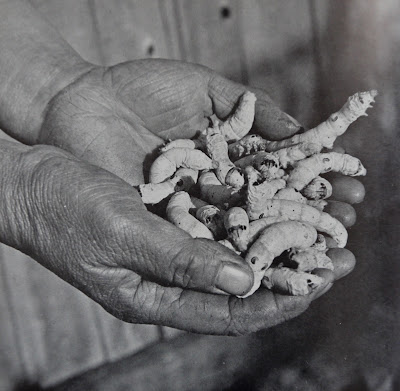"Teruko-san's day off. Didn't do much. Ann & I walked to Jelliffe's after lunch."
Diary Entry: April 16, 1954
"Met Clara Kessler in Kobe real early. Took express to Kyoto.
Left her bag in hotel & ate lunch in grill. Shopped at Oridono & then at bamboo shop. Met Elizabeth Angle & went to Tatsumura silk shop. Bought organdy & shantung at Oridono. Double shantung at Tatsumura.
Downtown to silk shop & had orange juice. Streetcar to see damascene. Elizabeth kept complaining about her wool undershirt. Took cab alone to Hankyu & came home without any trouble. My first adventure alone."
Diary Entry: April 17, 1954
"Children & I went with mission families to an Easter egg hunt at Rokko at home of Dr. Brown (mission doctor). Winnie Harbin S.S. class. She told story of Easter egg. Each child had cool-aid & cupcake. Each child got a basket & hunted eggs in big garden. Candy given to each child. Group composed of Swedish, Japanese, Americans & some nationalities I didn't know."
NOTE: Many visits were made to the silk mills and shops, alot of silk, and several books were purchased describing the process of cultivating silk worms. The images and explanations below are from one such book, Japan: Silk, by Horace Bristol, 1953. During that year alone, more than a million families were raising silk worms producing nearly 8 million pounds of raw silk. Finger weavers notched their nails in order to pull the threads in place while weaving.

Briefly, the process is as follows:
Selected moths lay eggs which are then examined for disease. Eggs are shipped to farmers for hatching.
Mulberry leaves are chopped and spread over trays of feeding worms.
When mature, the silk worms stop eating and are collected into large trays.
"Mounts" made of rice straw are spread onto bases for spinning cocoons. After spinning is finished, the cocoons are collected and shipped to the silk factory. It is interesting to note that because temperatures had to be kept at a specific level for the worms to develop, the family living room was often used. The constantly eating worms need fresh mulberry leaves at all times, feeding on a schedule of about every 4 hours. Although silk production is automated now, raising the worms still occurs as a cottage industry.











Very interesting to read about Silk production. Nice to know raising the Silk Worms is still a cottage industry.
ReplyDeleteIt is fascinating! Apparently the basic process hasn't changed that much over time.
ReplyDelete